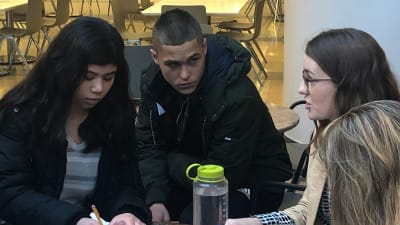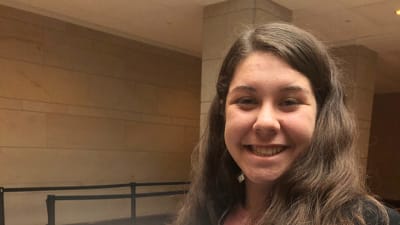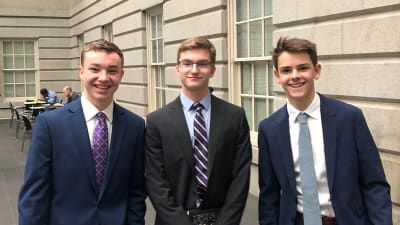Week One in Dc: Introduction to Ethical, Critical Thinking (with a Side of Impeachment)
In our first week we replace conventional classes with a series of learning adventures. These adventures encourage students to focus on critical thinking skills that will serve them at SEGL and beyond. This spring, our timing was serendipitous: our students got to test these new skills from the Senate gallery, listening live to the arguments in President Trump’s impeachment trial.
SEGL’s basic critical thinking framework is SEE – THINK – ACT – REFLECT. This four-step “STAR” process helps students evaluate information and choices in our “fake news,” “snap judgments” era. We’ll let the students explain each step in detail, but we spent most of this week learning how to see: Through which filters do we see the world, and how do those filters affect how we gather information? How do we gather information as objectively as possible, without jumping to conclusions?
We began the week with some ethical groundwork: The Infamous Skittles Scenario is the first stage of our “Introduction to Ethical Decision Making” case study (and an early SEGL rite-of-passage!). The interactive state-of-nature simulation has students chasing after plastic bags of candy and shouting with delight or dismay at 3×5 “Chance” cards. (What would you do if there were no rules and limited resources? Would you use that gun you found? Help out a suddenly-blind friend? Lie? Join a makeshift band of marauders? Form a “collective” that might turn sour if resources are light?) The conversation that followed was both reflective and energetic.
We then gave the students an introduction to classic Western ethical theory–Aristotle, Kant, and John Stuart Mill–a 30-minute lecture that provides important tools for future ethical decision making. (If you would like to see a seven-minute video of this lecture that was made for our online class several years ago, click here.) We also discussed Carol Gilligan’s feminist critique of moral development theory, In A Different Voice, and promised introductions to other ethicists as the semester continues.
After lunch we trekked to Lincoln Park (a few blocks from our residence) where we gathered around a sculpture in the park’s center. Should it stay? Be destroyed? Move to another location? Add an explanatory plaque? The session was a fascinating hands-on critical thinking experience, full of twists and turns as students dug beyond their first impressions. (To read Frederick Douglass’s dedication of the monument–itself a model of critical thinking–click here. You can read a longer blog post about this exercise by SEGL faculty member Lizzy Kildahl here.)
On Tuesday morning, at the unanimous request of students, we postponed our planned curriculum and gave student a two-hour “teach-in” introduction to the Trump impeachment trial.
We began with an exercise designed to help students understand the challenge of modern news production and consumption: after asking each student to write down the news sources she or he used most, we asked all students to arrange those sources on a matrix. On the “x axis” of that matrix was the liberal-conservative spectrum; on the y-axis how reliable each source was. The results were fascinating and showed both assumptions and blind spots in our group’s favorite news sources (the most popular quadrant was “liberal and reliable”–but can news be both politically biased and trustworthy?); it also helped create many questions for our guest experts.
The next hour was spent unpacking President Trump’s impeachment trial: What is the impeachment process, and when has Congress used it in the past? What is the history of U.S. involvement in Ukraine? Who is Hunter Biden, and why do many Republicans think his conduct is worthy of investigation? What is the President’s alleged misconduct at issue here, and why might it be illegal?
We then left for the U.S. Capitol, waiting in line with special gallery passes, moving through security, and ultimately looking down on history. Though there were no photographs allowed in the Senate chamber that day, there is no doubt that the image will remain in our students’ mind for many years to come. They returned to the dormitory full of wonder, excitement, and more questions.
With our stop-the-school “teach-in” complete, we returned to our regular curriculum. We started with an introduction to “dialogical thinking,” a concept championed by Richard Paul from the Foundation for Critical Thinking and the noted academic Cornel West, among others. We then jumped back into our study of the media with three rotating discussion groups, each addressing a different aspect of media literacy. (What causes us to trust news that might actually be false? How can we detect and evaluate such news?) We paid a visit to “in mid sentence,” an exhibit at the National Portrait Gallery depicting famous and everyday people in the process of communicating. In addition to using these photographs to practice the STAR method, the exhibit pushed students toward introspection. (All of our students are “in mid sentence” in some way: What have they said so far? How do they want their sentence to finish? What word should come next?) And finally, we discussed our summer reading: Mohsin Hamid’s The Reluctant Fundamentalist. The book brings together many elements from our first week, and prompted rich and substantive conversation.
On Thursday we put our students’ critical thinking skills to the test: a day-long journalism simulation. In groups of four, the students traversed the National Gallery of Art, imagining it was a Central Asian autocracy with a breakaway rebel province. Our faculty played various key leaders in what turned out to be a dramatic series of events. The catch? Through shrewd observation, questioning, and research, our students had to figure out which (if any) of the leaders to believe. What was really going on? The day culminated in three-minute on-the-scene video presentations in which each group decided what to share, and how. (What was the truth? You’ll have to ask a student!)
On Friday morning we discussed the latest brain science research about learning, and the students buzzed in rotating discussion groups about listening to music while studying, “iDisorders,” and the dangers of the “fixed intelligence mindset.”
Then it was time to welcome our first guest expert of the semester: three-time Pulitzer Prize-winning journalist Eric Schmitt. Among other distinctions, Schmitt was the New York Times‘ main contact for WikiLeaks founder Julian Assange, covered the Clinton impeachment trial, and once climbed into Saddam Hussein’s final hiding place (without permission!). Schmitt has ample experience wrestling with the ethical issues our case study raised. The students heard stories from his many “embeddings” abroad, his take on President Trump and the current media landscape, and his advice for news readers in the “fake news” era.
Schmitt is the first of several journalists we will visit with over the next four months (the next is Mara Liasson, NPR’s national political correspondent and a frequent guest on Fox News). We hope these visits, sprinkled throughout the semester, will help students keep their critical thinking skills honed and close at hand.
This week brings our first set of traditional classes and our case study on the 1994 Rwandan genocide. More soon!
































